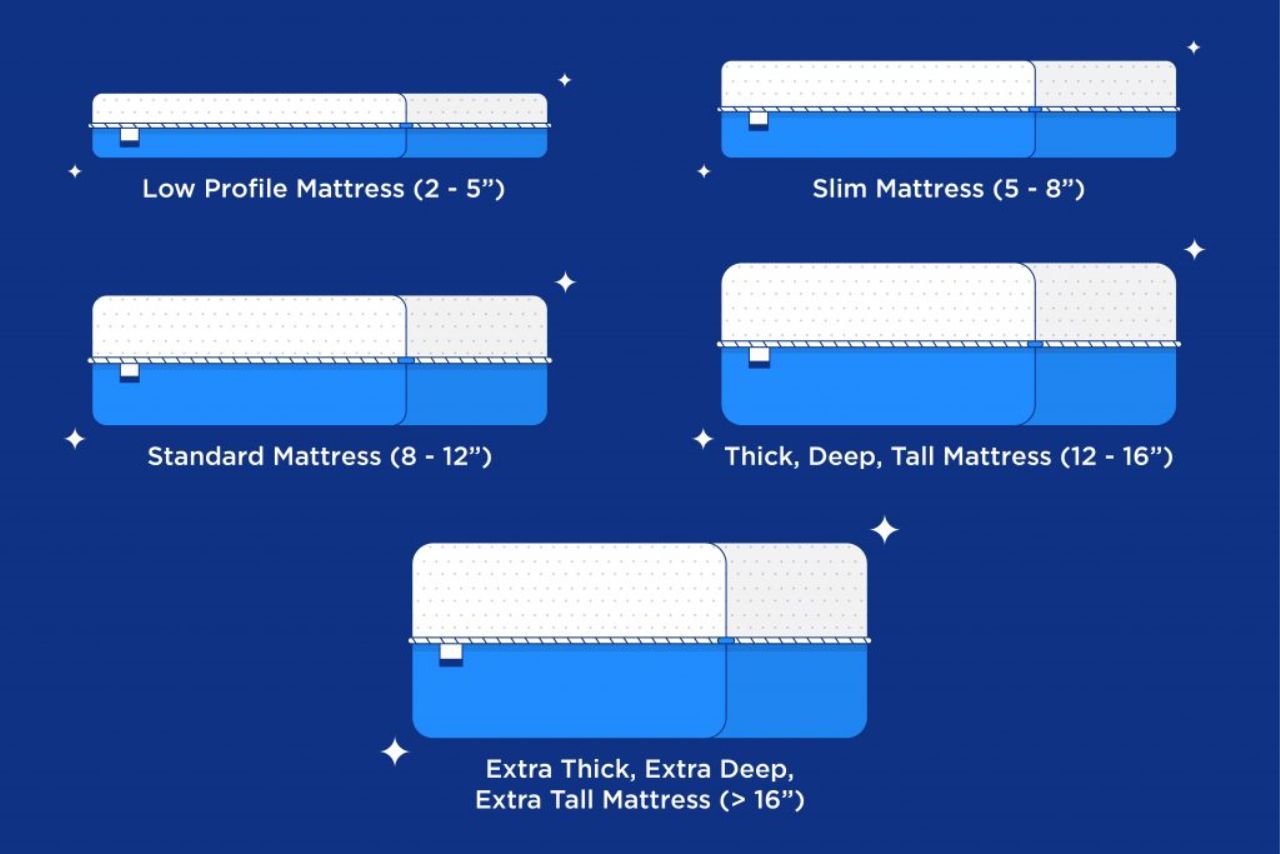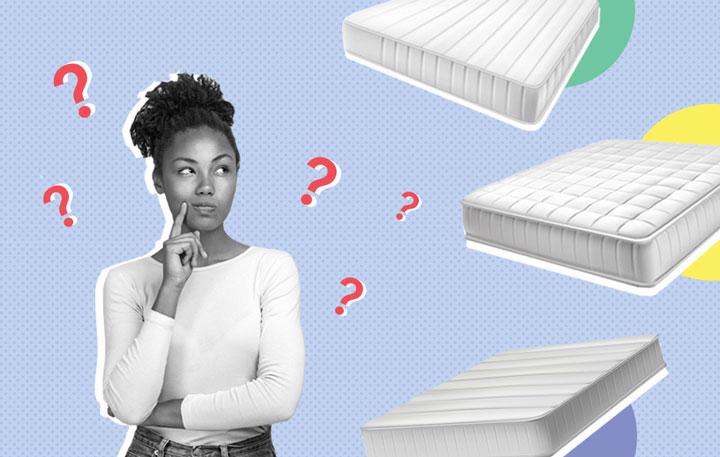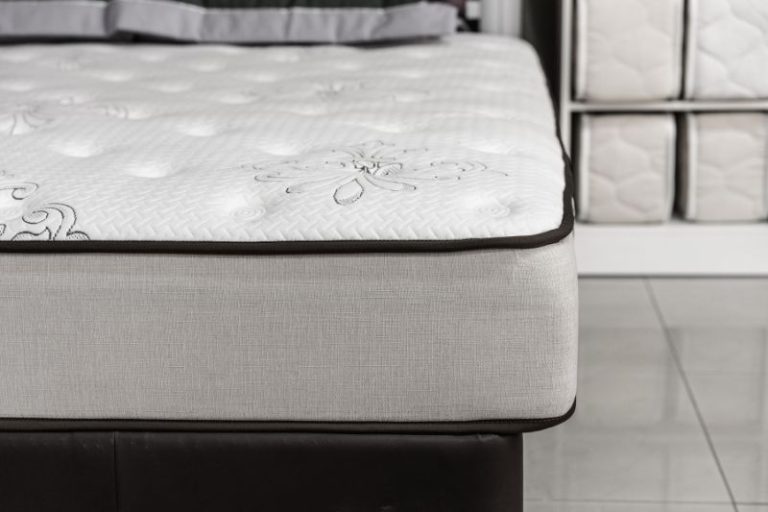How Thick Should Your Mattress Be? (Exploring the Truth!)

How Thick Should Your Mattress Be?
The thickness of a mattress largely depends on personal preference and body weight. Generally, a mattress thickness of 10-12 inches is suitable for most people. However, heavier individuals may prefer a thicker mattress to provide more support, while lighter individuals may find a thinner mattress more comfortable. Ultimately, it’s important to choose a mattress that feels comfortable and supportive to you.
The ideal thickness of a mattress depends on various factors such as personal preference, body weight, and sleeping position.
Finding the perfect balance between comfort and support is key when determining the thickness of your mattress.
Too thin, and you may not get adequate pressure relief; too thick, and you might sink uncomfortably or feel too warm during the night.
Consider your specific needs along with expert recommendations to ensure that you select a mattress that provides optimal comfort throughout the night.
Now let’s delve deeper into what factors influence mattress thickness so you can make an informed decision tailored to your preferences and requirements.
Benefits of a Thick Mattress:
A thick mattress can offer several benefits that contribute to a comfortable and restful sleep experience.
Here are some advantages of choosing a thicker mattress:
- Enhanced Support: A thick mattress provides improved support for your body, especially for individuals with joint or back pain. The extra padding helps distribute your weight evenly and reduces pressure points, promoting proper spinal alignment.
- Superior Comfort: With its additional layers of cushioning, a thick mattress offers enhanced comfort levels compared to thinner options. It allows you to sink into the bed slightly, providing a plush feel that can be particularly appealing if you prefer softer sleeping surfaces.
- Motion Isolation: Thicker mattresses tend to have better motion isolation properties than their thinner counterparts. This means that when one person moves or gets out of bed, the movement is less likely to disturb their partner’s sleep on the other side.
- Durability: Generally, thicker mattresses tend to be more durable due to increased material density and construction quality. They can withstand regular use over an extended period without losing their shape or supportiveness.
- Versatility in Sleeping Positions: A thicker mattress accommodates different sleeping positions with ease by offering adequate contouring and support for each position—whether you sleep on your back, side, stomach or switch between them during the night.
- Temperature Regulation: Some thick mattresses incorporate advanced cooling technologies such as gel-infused foams or breathable materials that help dissipate heat effectively throughout the night, ensuring optimal temperature regulation and preventing overheating.
- Luxurious Feel: If you desire a luxurious hotel-like sleeping experience at home, a thick mattress adds an element of opulence by creating a substantial visual presence in your bedroom while delivering exceptional comfort every night.
Remember that while these benefits make thicker mattresses attractive choices for many people seeking superior comfort and support in their sleep environment, personal preferences and individual body types should also be considered when selecting the ideal mattress thickness for your needs.
Factors to Consider When Choosing Mattress Thickness:
When choosing the thickness of your mattress, there are several factors you should consider.
Here are some key points to keep in mind:
- Comfort: The thickness of a mattress can greatly impact your comfort level. A thicker mattress tends to provide more cushioning and support, making it ideal for individuals who prefer a softer sleeping surface.
- Body Weight: Your body weight plays a significant role in determining the appropriate mattress thickness. Heavier individuals may benefit from a thicker mattress as it offers better support and prevents sinking too far into the bed.
- Sleeping Position: Different sleeping positions require varying levels of support and alignment. Back sleepers usually find medium-thick mattresses most comfortable, while side sleepers often prefer slightly thicker options to alleviate pressure on their shoulders and hips. Stomach sleepers generally do well with firmer, thinner mattresses.
- Health Conditions: Certain health conditions such as back pain or joint problems may influence your choice of mattress thickness. Thicker mattresses with extra padding can help relieve pressure points and promote spinal alignment for those with specific needs.
- Bed Base Compatibility: It’s essential to consider if your chosen bed base is compatible with the desired mattress thickness since some frames or foundations have limitations on how thick the mattress can be.
- Room Size: Another factor to take into account is the size of your bedroom or living space where the bed will be placed. If you have limited space, opting for a thinner mattress could be more practical without compromising comfort.
Remember that these factors are guidelines rather than strict rules when selecting your ideal mattress thickness.
Effects of Sleeping on a Thin Mattress:
Sleeping on a thin mattress can have several negative effects on your sleep quality and overall health.
Here are some key points to consider:
- Lack of support: Thin mattresses often lack proper support, leading to inadequate spinal alignment during sleep. This can result in discomfort, back pain, and poor sleeping posture.
- Pressure points: With insufficient cushioning, your body is more likely to experience pressure points where the mattress presses against your joints and other sensitive areas. This can cause discomfort and restrict blood circulation, leading to tossing and turning throughout the night.
- Motion transfer: A thin mattress may not effectively absorb or isolate motion when you or your partner move during sleep. This means that any motion created by one person will be felt by the other, potentially disturbing their restful sleep.
- Increased risk of allergies: Thin mattresses typically have less padding and are more prone to accumulating dust mites, allergens, and bacteria over time. These microscopic particles can trigger allergies or respiratory problems for individuals who are sensitive or prone to such reactions.
- Decreased durability: Thinner mattresses generally have a shorter lifespan compared to thicker ones due to their lower density materials and construction methods. This means they may lose their shape quickly, develop lumps or indentations faster than expected, requiring replacement sooner than desired.
To ensure optimal comfort and support while sleeping:
- Consider investing in a thicker mattress with adequate layers of high-quality foam or spring coils.
- Look for mattresses that offer proper lumbar support for maintaining the natural curvature of your spine.
- Opt for a medium-firm level of firmness as it provides both comfort and sufficient support.
- Regularly clean your mattress using appropriate methods suggested by the manufacturer to prevent allergen buildup.
Remember that everyone’s preferences differ when it comes to mattress thickness; however, choosing one that offers ample support and comfort is essential for a good night’s sleep.
Finding the Right Thickness for Your Sleep Style:
When it comes to choosing the thickness of your mattress, it’s important to consider your sleep style and personal preferences.
Here are some factors to keep in mind:
- Back Sleepers: If you primarily sleep on your back, a medium-firm mattress with a thickness of around 10-12 inches is usually recommended. This provides enough support to keep your spine aligned while still offering some cushioning.
- Side Sleepers: Side sleepers generally benefit from a slightly softer mattress that can relieve pressure points on their shoulders and hips. Look for a mattress with a thickness between 12-14 inches, preferably with additional comfort layers such as memory foam or latex.
- Stomach Sleepers: For those who prefer sleeping on their stomachs, a firmer mattress is ideal to prevent excessive sinking of the hips and lower back pain. A medium-firm to firm mattress with a thickness of 10-12 inches should provide adequate support.
- Combination Sleepers: If you tend to change positions throughout the night, consider opting for a versatile mattress that strikes a balance between support and comfort. Medium-firm mattresses in the range of 10-12 inches are often suitable for combination sleepers.
- Body Weight Considerations: Heavier individuals may require thicker mattresses (around 12-14 inches) to ensure proper support and prevent sagging over time, while lighter individuals might find thinner options (8-10 inches) more comfortable.
Remember that these recommendations serve as general guidelines, and individual preferences may vary based on factors such as body type, existing health conditions, or personal comfort preferences.
It’s always advisable to try out different mattresses if possible before making a purchase decision or refer to manufacturer guidelines specific to each model you’re considering.
How to Measure the Ideal Thickness for Your Body Type?
When choosing a mattress, it’s important to consider your body type to ensure optimal comfort and support.
Here are some steps to help you measure the ideal thickness for your specific needs:
- Determine your body weight:
- Weigh yourself using a scale.
- Note down your weight in pounds.
- Assess your sleeping position:
- Consider whether you sleep on your back, side, or stomach.
- Different positions require varying levels of support.
- Understand firmness preferences:
- Decide if you prefer a soft, medium, or firm mattress.
- Soft mattresses provide more cushioning while firm ones offer greater support.
- Research recommended thickness ranges:
| Body Type | Recommended Mattress Thickness Range |
|---|---|
| Petite (less than 130 lbs) | 8-10 inches |
| Average (130-230 lbs) | 10-12 inches |
| Plus-size (over 230 lbs) | 12+ inches |
- Consider personal preferences and conditions:
- If you have back pain or joint issues, opt for thicker mattresses with additional padding.
- Test different options:
- Visit local stores and try out various mattresses within the recommended range for your body type.
Remember that these thickness ranges are general guidelines and can vary depending on individual preferences and needs.
It’s essential to find a balance between comfort and support that aligns with both your body type and sleeping habits.
By following these steps, you’ll be able to determine the ideal thickness of a mattress that will provide maximum comfort and improve the quality of your sleep experience based on what suits you best!
Common Misconceptions About Mattress Thickness:
When it comes to mattress thickness, there are several common misconceptions that people often believe.
Let’s debunk these myths and provide you with the facts:
- Thicker means more comfortable: Many people assume that a thicker mattress automatically translates to better comfort. However, this is not always the case. The comfort level of a mattress depends on various factors such as materials used, firmness level, and individual preferences.
- Thick mattresses are always better for back pain: While a supportive mattress can alleviate back pain, it doesn’t necessarily mean it has to be overly thick. The key factor here is proper support for your body’s natural alignment rather than just the thickness.
- All mattresses have standard thickness: There is no one-size-fits-all when it comes to mattress thickness. Different types of mattresses like memory foam, innerspring, or latex may vary in their recommended thickness range based on their construction and intended use.
- More coils mean a thicker mattress: Coils play an important role in providing support in some types of mattresses like innerspring ones but they don’t directly determine its overall thickness.
- A thick pillow-top equals extra cushioning: Pillow-top mattresses offer additional padding on top for enhanced comfort but this does not necessarily make them thicker overall compared to non-pillow-top options.
- Thickness determines durability: Although some might think that thicker mattresses are more durable due to extra material layers involved, durability primarily depends on the quality of materials used and construction techniques employed by manufacturers rather than solely relying on thickness measurements.
Remember that choosing the right mattress should be based on your personal preferences regarding firmness levels, sleeping positions, body weight distribution, and any specific needs you may have (e.g., allergies).
Don’t let misconceptions about mattress thickness sway your decision-making process; focus instead on finding a well-constructed mattress that suits your individual needs.
Tips for Maintaining and Caring for Different Mattress Thicknesses:
When it comes to mattress thickness, there are a few tips you can follow to ensure your mattress stays in good condition.
Here are some guidelines based on different mattress thicknesses:
1. Thin Mattresses (6 inches or less)
- Rotate the mattress regularly: Thin mattresses tend to wear out faster than thicker ones, so rotating them every three months can help distribute the weight evenly.
- Use a supportive foundation: A thin mattress will benefit from a solid foundation, such as a platform bed or slatted base with no more than 3-inch gaps between slats.
- Avoid jumping or excessive pressure: Thin mattresses may not be able to handle heavy impacts well, so avoid jumping on them or placing excessive weight in one area.
2. Medium-thick Mattresses (8-10 inches)
- Clean regularly: Vacuuming your medium-thick mattress once every couple of months will help remove dust and allergens that may accumulate over time.
- Invest in a quality protector: A waterproof and breathable mattress protector will safeguard against spills, stains, and moisture accumulation.
- Flip and rotate seasonally: To maintain even wear, flip your medium-thick mattress twice per year – once during springtime and again during fall.
3. Thick Mattresses (12 inches or more)
- Consider deep-pocket sheets: Thick mattresses often require deep-pocket fitted sheets to accommodate their height without straining the elastic edges.
- Optimize support system: Ensure that your thick mattress is properly supported by using a sturdy box spring or adjustable bed frame designed for heavier loads.
- Air it out occasionally: Thicker mattresses tend to retain heat more than thinner ones; therefore, airing out your thick mattress periodically can help prevent odors caused by trapped moisture.
Remember that these tips serve as general guidance when caring for different thicknesses of mattresses. Always refer to the manufacturer’s recommendations for specific care instructions to maximize the lifespan and comfort of your mattress.
Conclusion: How Thick Should Your Mattress Be?
In conclusion, the thickness of your mattress plays a crucial role in determining your sleep quality and overall comfort.
It is essential to consider various factors such as personal preference, body weight, and sleeping position when selecting the ideal mattress thickness.
A thicker mattress provides more support and cushioning, which can be beneficial for individuals with back pain or joint issues.
On the other hand, a thinner mattress may be suitable for those who prefer a firmer feel or have specific sleep preferences.
Ultimately, finding the right balance between comfort and support is key to ensuring a good night’s sleep.
Remember that there is no one-size-fits-all answer when it comes to choosing the perfect mattress thickness.
Take into account your individual needs and preferences before making a decision.
By understanding how different thicknesses can impact your sleep experience, you’ll be better equipped to make an informed choice that leads to restful nights and refreshed mornings.






